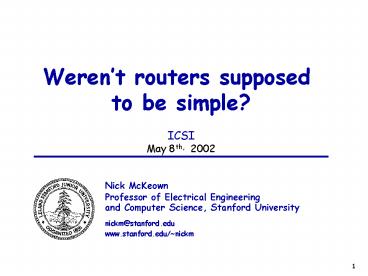CS244a: An Introduction to Computer Networks - PowerPoint PPT Presentation
Title:
CS244a: An Introduction to Computer Networks
Description:
We tell our students that Internet routers are simple. ... Others: Drop policies, VPNs, ACLs, DOS traceback, measurement, statistics, ... – PowerPoint PPT presentation
Number of Views:39
Avg rating:3.0/5.0
Title: CS244a: An Introduction to Computer Networks
1
Werent routers supposed to be simple? ICSI May
8th, 2002
Nick McKeown Professor of Electrical Engineering
and Computer Science, Stanford
University nickm_at_stanford.edu www.stanford.edu/ni
ckm
2
Background
- We tell our students that Internet routers are
simple. All routers do is make a forwarding
decision, update a header, then forward packets
to the correct outgoing interface. - But I dont understand them anymore.
- List of required features is huge and still
growing, - Software is complex and unreliable,
- Hardware is complex and power-hungry,
- Yet still the throughput is less than 100.
3
Outline
- What limits the performance of a router
- What are the basic requirements
- Basic functions RFC 1812
- Throughput
- 0.25s of Buffering
- What are the new requirements
- Multicast
- IPv6
- DiffServ, IntServ, priorities, WFQ etc.
- Latency
- Packet sequence
- Others Drop policies, VPNs, ACLs, DOS traceback,
measurement, statistics, - What might be possible
4
Generic router architecture
5
Generic router architecture
Queue Packet
1
1
Buffer Memory
2
2
Queue Packet
Buffer Memory
Scheduler
Queue Packet
N
N
Buffer Memory
6
Router linecard
OC192c linecard
- Buffer
- State
- Memory
Lookup Tables
Optics
Packet Processing
Buffer Mgmt Scheduling
Physical Layer
Framing Maintenance
Buffer Mgmt Scheduling
- 30M gates
- 2.5Gbits of memory
- 2 square feet
- 25k cost, 200k price.
- Buffer
- State
- Memory
Scheduler
7
Router vital statistics
Cisco GSR 12416
Juniper M160
19
19
Capacity 160Gb/sPower 4.2kW
Capacity 80Gb/sPower 2.6kW
6ft
3ft
2ft
2.5ft
8
DWDM Link speed x2/8 months
Internet x2/yr
Router capacity x2.2/18 months
Moores law x2/18 m
DRAM access rate x1.1/18 m
9
An Example Packet buffers40Gb/s router linecard
10Gbits
Buffer Memory
Buffer Manager
10
An Example Packet processing
CPU Instructions per minimum length packet since
1996
11
Will we need faster routers?
- If in 10 years we have a 210 1024-fold increase
in capacity of the Internet, we wont have 1024
times as much POP space to hold the routers, 1024
times as many batteries, 1024 times as many fans.
12
Outline
- What limits the performance of a router
- What are the basic requirements
- Basic functions RFC 1812
- Throughput
- 0.25s of Buffering
- What are the new requirements
- Multicast
- IPv6
- DiffServ, IntServ, priorities, WFQ etc.
- Latency
- Packet sequence
- Others Drop policies, VPNs, ACLs, DOS traceback,
measurement, statistics, - What might be possible
13
The Problem
- Output queued switches are impractical
R
R
R
R
DRAM
data
NR
NR
14
Potted history
- Karol et al. 1987 Throughput limited to
by head-of-line blocking for
Bernoulli IID uniform traffic. - Tamir 1989 Observed that with Virtual Output
Queues (VOQs) Head-of-Line blocking is reduced
and throughput goes up.
15
Potted history
- Anderson et al. 1993 Observed analogy to
maximum size matching in a bipartite graph. - M et al. 1995 (a) Maximum size match can not
guarantee 100 throughput.(b) But maximum weight
match can O(N3). - Mekkittikul and M 1998 A carefully picked
maximum size match can give 100 throughput. - Prabhakar and Dai 2000 100 throughput possible
for maximal matching with a speedup of two.
Matching O(N2.5)
16
Throughput results
Theory
Input Queueing (IQ)
58 Karol, 1987
Practice
Input Queueing (IQ)
Various heuristics, distributed algorithms, and
amounts of speedup
17
Outline
- What limits the performance of a router
- What are the basic requirements
- Basic functions RFC 1812
- Throughput
- 0.25s of Buffering
- What are the new requirements
- Multicast queues, bandwidth, backpressure,
lookups, dropping. - IPv6
- DiffServ, IntServ, priorities, WFQ etc.
- Latency 125us, pipelines, cell size.
- Packet sequence parallelism and load-balancing.
- Others Drop policies, VPNs, ACLs, DOS traceback,
measurement, statistics, - What might be possible
18
What might be possible
Router
1
rate, R
rate, R
1
1
2
rate, R
rate, R
N
N
k
Bufferless
19
Characteristics
- Advantages
- kh a memory bandwidth i
- kh a lookup/classification rate i
- kh a routing/classification table size i
- Problems
- Throughput
- Multicast
- Packet order
- Latency
- Priorities and QoS
20
Intriguing possibility Two-stage Load-Balancing
Router
External Outputs
External Inputs
Buffers
1
N
Recently shown to maximize throughput
C.S.Chang et al. http//www.ee.nthu.edu.tw/csch
ang/PartI.pdf
21
Optical two-stage router
Linecards
Lookup
Phase 1
Buffer
1
Lookup
Buffer
2
Phase 2
Lookup
Buffer
3
22
100s of Tb/s router projectMark Horowitz, David
Miller, Olav Solgaard, Nick McKeown
Passive Optical Switch
Electronic Linecard 1
Electronic Linecard 625
160- 320Gb/s
160- 320Gb/s
40Gb/s
- Line termination
- IP packet processing
- Packet buffering
- Line termination
- IP packet processing
- Packet buffering
40Gb/s
160Gb/s
40Gb/s
40Gb/s
(100Tb/s 625 160Gb/s)
23
What Hurts
- Maintaining packet order
- Buffering packets in external DRAM
- What Seems Impractical
- Low latency
- Multicast
- Delay guarantees































